Recreating My Amish-Mennonite Grandmother's Garden
OR - mostly failing to recreate her garden but continuing to try anyway.
My husband and I set our farm and garden goals a few months back.
We’re unusually excited (and a little nervous) about our 2023 farm goals. The American Peony Society will be touring our peony fields as part of their 2023 National Convention. We’re hoping to expand our cut flower sales to include more florists. And we have at least 1000 more cut flower perennials to plant this spring alone. In fact our very first flat of plugs arrived just today!
But I’m anticipating our personal garden goals even more this year. Perhaps because for the first 4-5 years on this farm we mostly ignored the existing decorative borders.
Which was a shame.
Because this farm’s prior owner was an artist. Her creative talent sang through the flower beds, showing up despite me forsaking them. She’d filled the beds with tough but beautiful plants. A variety of hostas, tall garden phlox that freely self seeded, hardy geraniums, day lilies and regrettably. a clematis that did not survive my benign neglect.
But since at least 2019 we’ve set small, incremental goals for our decorative gardens. We’ve been editing out the weeds bit by bit, leaving the self-sown wildflowers. Dividing and transplanting many of the existing plants, adding in more plants to densify the planting and eliminating patches of bare soil.
In this way we’ve mostly reclaimed the previous owner/s flower beds, albeit with our own touches added.
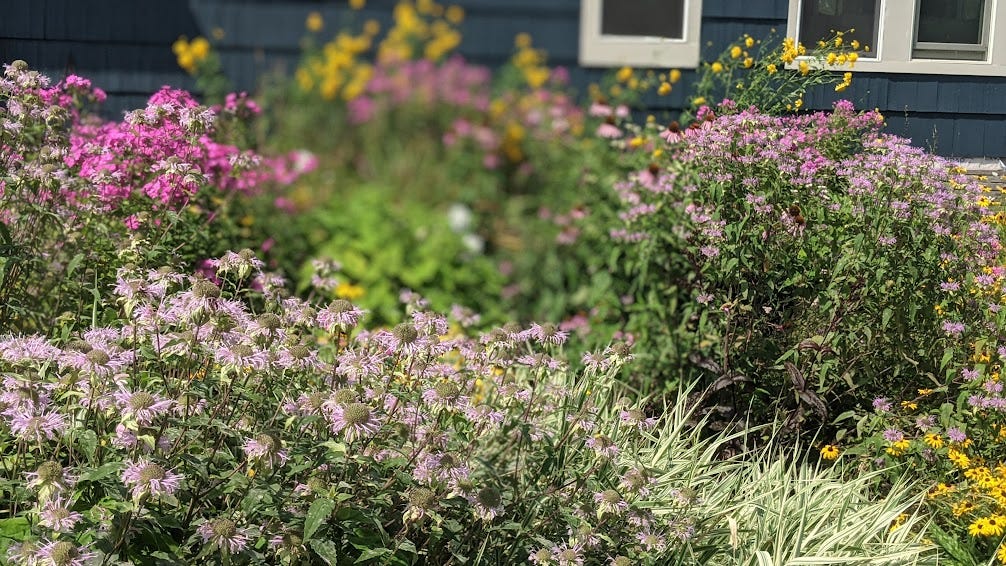
We also added a fairly large bed sitting in between our house and our flower production fields. This border we didn’t inherit. We started it from scratch because honestly, something had to stop me seeing my commercial fields while washing dinner dishes and therefore frantically thinking, “Now how on earth can we get all THAT done?”
The borders aren’t perfect - I have no time nor energy for perfection - but the beds sparkle with color and wildlife activity and that feels just about right most days.
This year our slow garden journey continues. In that spirit, we’ll chip away at 3 garden goals in 2023.
Reorganize the decorative bed sitting in between our fields and our house so that it’s easier to maintain. (I love a good curved pathway but overdid it in this garden, making it challenging to keep paths weed free. Sadly I need a few more straight lines I think).
Set up a more permanent outdoor space for our family to sit and enjoy summer evenings. (Right now we sit in our driveway. Seriously. 38 acres of land and the driveway is the best we can do??? I write this with shame).
Keep trying to recreate the spirit of my grandmother’s traditional, Amish-style vegetable garden - hands down, my favorite goal this year.
For all these goals I’m looking forward to sharing our progress and missteps with you throughout the coming season. But for today, let’s talk about my favorite and most elusive goal - recreating my grandmother’s garden.

I grew up with stories of how my Amish-Mennonite Grandmother grew flowers in her vegetable garden. She had peonies - deep red and pink - along the fence at the end of the garden. Sweet peas grew on the fence by the entrance gate. Clumps of deep red dahlias and zinnias lined the garden paths.
For years now, these stories inspired me to tuck veg in my decorative beds. I did this in a haphazard, cottage-garden way - not in a structured design like my grandmother did.
But a few years ago, I visited my Amish friend, Emma and there it was - a modern-day version of my Grandmother's garden.
I was shocked - I’d seen countless other Amish vegetable gardens and none were designed in that way. Even more surprising, as I became more familiar with Emma’s particular Amish community, I learned that all the women used a version of this style to design their veg patches.
Whatever tradition had been passed down in my family, had been passed down in Emma’s community as well.
Encircling her vegetable garden, Emma had planted a perimeter of flowering annuals and perennials. Nearby, she had beds overflowing with Peonies and Dahlias. The effect was even more beautiful than I’d envisioned.
(Here’s where I wish I’d taken pictures of Emma’s garden. I even googled “Amish vegetable gardens” to see if I could find any designed in this style. No luck. So hopefully l’ll get pics of Emma’s garden later this year and share them then).
I was hooked. Each year since, I’ve been trying to recreate the spirit of my grandmother’s vegetable patch. I've planted sweet peas on the fence. And added a decorative front row to our current veg garden.
I planted 2 hardy perennials - daisies and yarrow. And - during the frost-free season, I packed in three different kind of dahlias, nicotiana, zinnias and marigolds.
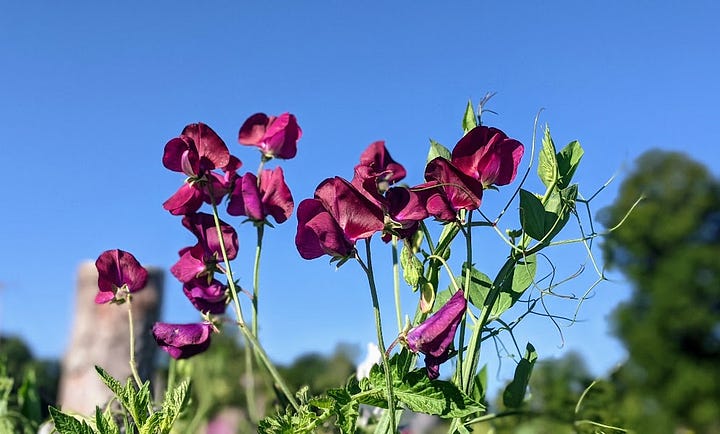
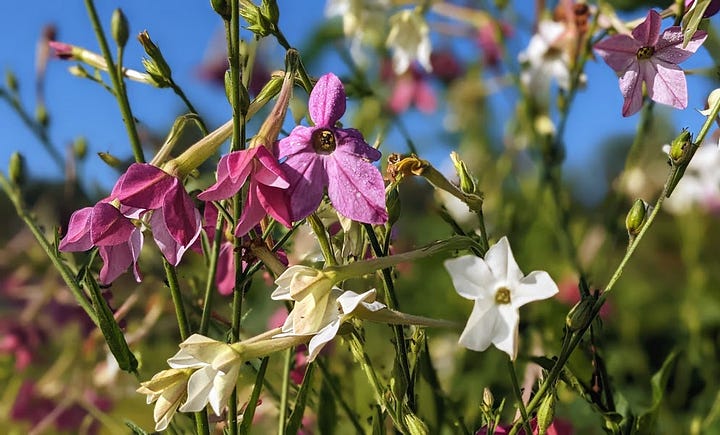
Honestly?
It was just ok. The sweet peas were a triumph - flowering steadily from late June right up to frost. But the rest was… “meh.”
So here’s what I’m thinking about for this year.
Last fall I planted a row of about 30 “Primevere” Peonies across the path from the veg patch.
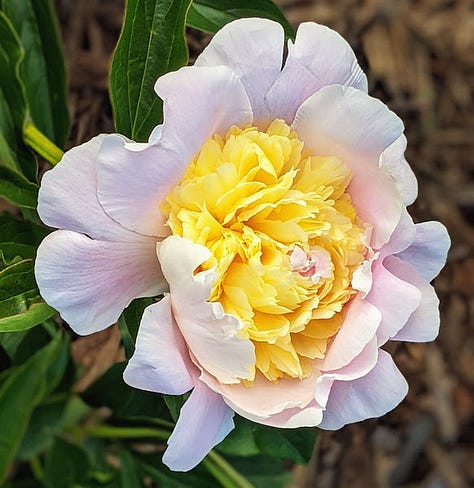

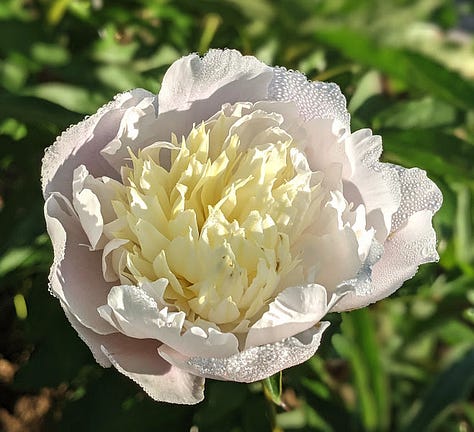
This year I’ll interplant those with other perennials. Possibly some of the “Favorite Berries” yarrow I already have going in the grow room. I also want something tall, pink and spiky there. My dream would be Veronica “Skyler Pink” but - to keep costs down may just do “Potomac Pink” snapdragons for this year. I already have 2 trays of those going too.
Around the border of the veg patch itself, I want to add in a more permanent backbone that plays well with the row of Primevere Peonies across the way. I’m thinking of adding Joe Pye Weed, some native dogwood and few Annabelle Hydrangea - I’m considering a mix of “Incrediball ” (the original, white one) and/or “Sublime,” a newer lime green introduction. (Photo credit for “Sublime” - Spring Meadows Nursery. Fantastic selection of hydrangea if you’re buying wholesale).
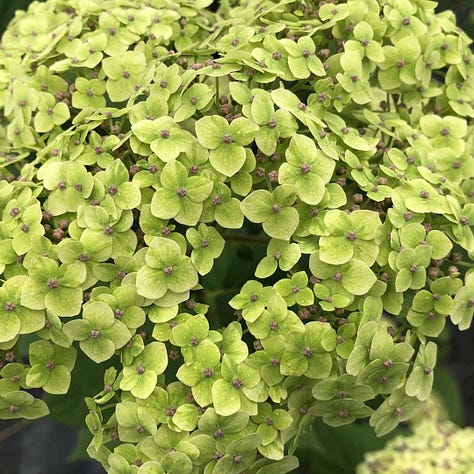

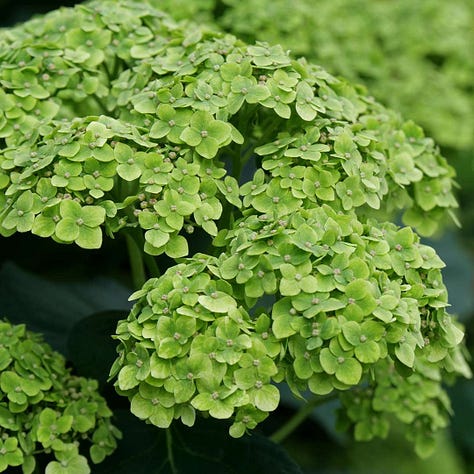
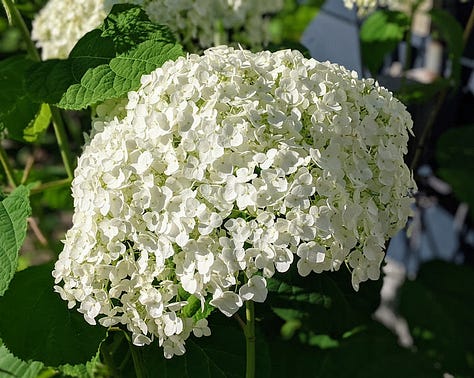
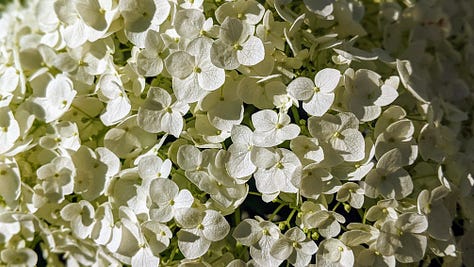
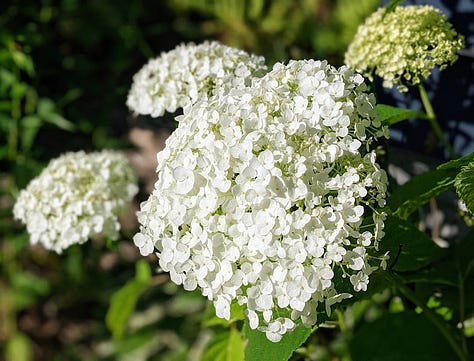
For warm season annuals, I’ll definitely keep the Nicotiana and Zinnias. Last year I planted long-time favorite - Nicotiana “Perfect Mix” and have some started for this year too. For zinnias, I’m still deciding - but will probably go with “Oklahoma Pink” and/or “Zinderella Peach”?
I’m leaving the shasta daisies and the “Red Shades” yarrow I started from seed and planted last year and. And just for height, I may transplant in some species foxglove.
And then for my conundrum - which dahlia? I want a pink, preferably a ball type? I LOVE “Linda’s Baby,” “Caitlin’s Joy” and “Bracken Rose” but selfishly want to save those tubers for our cut flower fields. I’m considering “Doris Duke.” Love the color. Has anyone grown and liked it?
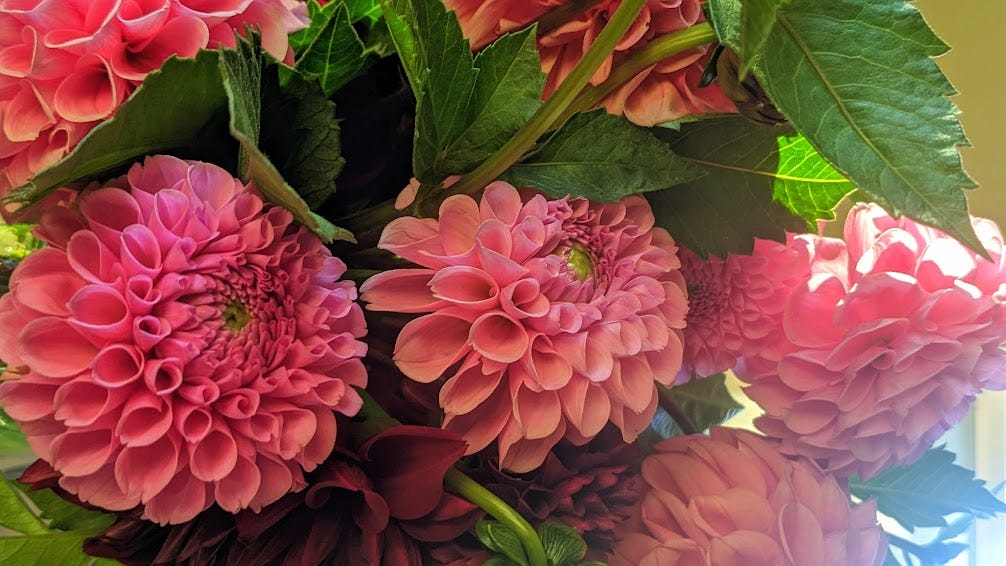
Who knows - maybe the veg garden design will work this year.
Maybe it won’t.
Maybe each year I’ll just keep tweaking the planting until I stumble on a combination that satisfies the buzzing inside my head, replacing it with a satisfied quiet that whispers, “Yes. There it is.”
(People - this is why I’m a farmer not a designer. Can you imagine putting a client through all this?)
But let me set my excitement about the growing season aside for a moment. And admit that I’ve grown cautious about my relationship goals - even to lovely ones.
To be clear, for me goals are essential to human thriving. And achieving them can also do a lot of good.
AND… I’ve come to see I’ve sometimes used achievement to reassure myself I’m “good enough.” Or when I can’t achieve - to convince myself that I am not.
Worse yet, when I’ve been most effective - knocking all my goals out of the park - I’ve sometimes done so at the cost of my own empathy. I’ve become less understanding when those around me don’t reach their goals. Even when it’s due to real-life barriers - debilitating illness, profound caring responsibilities, economic constraints.
Sadly, I don’t think this moral failing is mine alone. If I spend 5 minutes on social media, I see others grappling with their own perspective on goals.
I particularly see this show up in the “encouraging” messages proclaiming “anyone” can achieve their goals if they have enough grit, focus and faith.
And its kissing cousin - if you’ve failed to achieve your goals, here are all the things you need to change about yourself so you’ll stop being such a failure.
When I’ve been at my lowest - when just getting out of bed felt like victory. or when family care responsibilities left no room for dreams of my own - neither of these messages helped change the things that bound me.
Neither left room for a life framed by constraints I had not chosen. Indeed - if “anyone can do it,” and I know I can’t, then am I not “anyone?” Am I in fact the “no one” I fear myself to be?
To be clear - I’ve done this to others too. I’ve sat with people caught in the jaws of bone-crushing circumstances and offered “helpful” advice about how they could change their situation.
When in reality - what they actually needed was someone to listen quietly and help them grieve the near complete lack of control they faced in that moment.
So I’m craving a shift in how we view goals. A move away from the “anyone can do this” mentality to one that goes more like this:
Some things are possible, on some days.
Some days, very little is possible.
It’s not just you - it’s all of us.
We don’t have answers.
But we’re listening for whatever you need to say.
It’s not snappy. And won’t get me a million Instagram followers. But I suspect it’s much closer to what many of us hope to hear.
Obviously, I’m not giving up my own goals And I still get immense joy watching others go after their goals too. There’s so much to love in that collective experience of striving.
But each morning as I plan my day, I hope I can stop wearing my “Productiveness-Is-Next-To-Godliness” hat and instead live this uncomfortable truth:
Some things may be possible today.
Some things may not.
And my job is to strive to hear all of it.




Not for this year (it's sold out), but Old House Gardens sells a dahlia called Wisconsin Red that is especially easy to winter over and has survived over the years as a passalong plant. (Story here: https://oldhousegardens.com/MoreAboutWisconsinRed) It fits into your vibe of a "farmer's wife" garden--that's what I call pretty plants that take care of themselves, like the plants in your grandmother's garden. Lilacs qualify, too. In the old days, a farmer's wife was way too busy doing her share to keep the farm running to have time for plants that needed fussing, but she did appreciate beauty when it was easy.